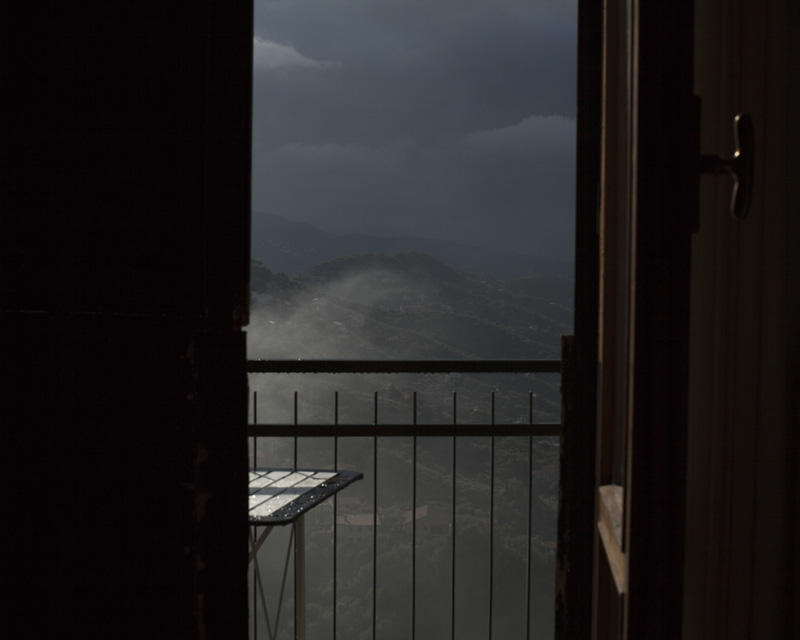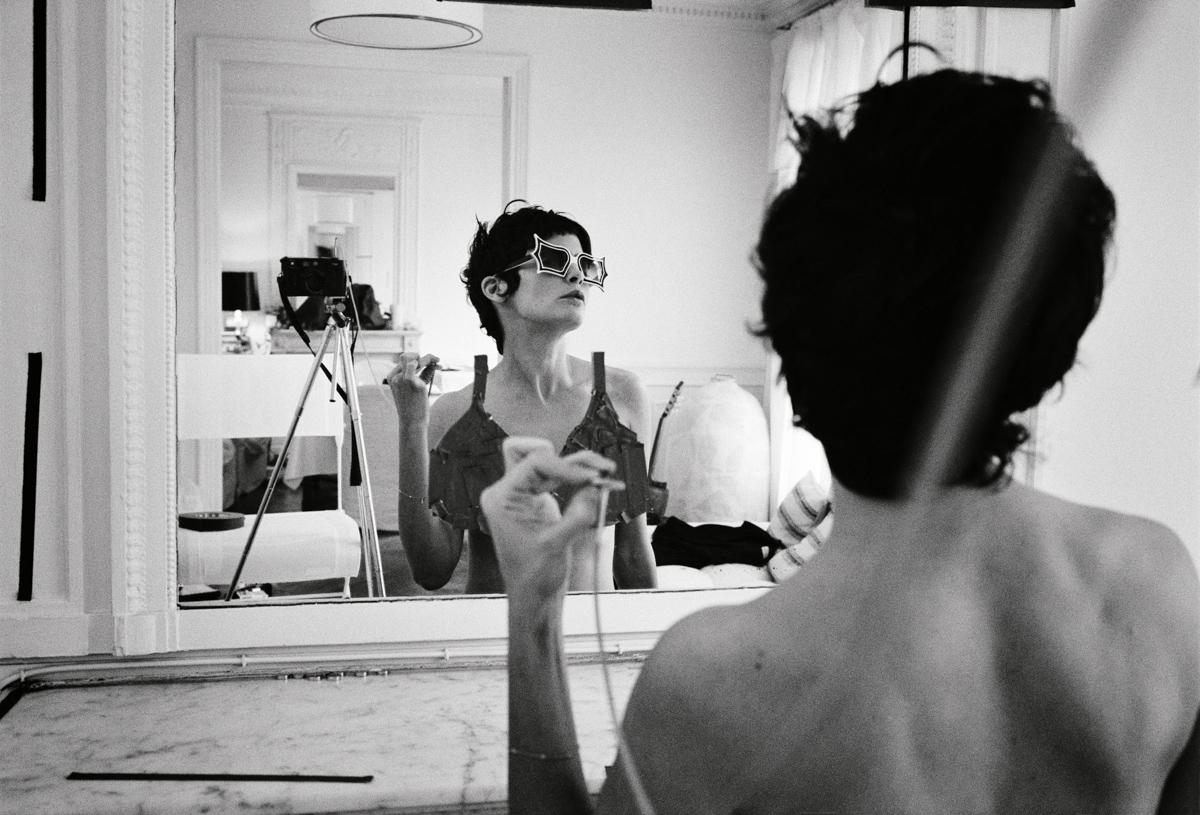"Because it was about a state of mind, I knew that it was something that was going to have me throwing myself against the limits of representation. Translating emotionality and personal experiences into a picture is always going to be hard. "—Katrin Koenning, in our interview about her photography.
The Means of Production: An Interview with Evan Baden Changing the equation on book publishing with DIY
 Photographic artist Evan Baden kicks off a new independent press, Push Pull Editions, with the publication of Schools for the Colored, a black and white documentary project by Guggenheim Fellow Wendel A. White. Baden makes the books himself, in-house from start to finish, in modest edition sizes. His do-it-yourself book production may not be scalable enough to reach mass audiences, but it does offer freedom in his chosen projects. The goal, he emphasizes, is to make books that he likes, in the manner and speed that he likes. In this interview, he speaks about putting together a printing press on a shoestring budget, the economics of making a photobook, and how he sees the difference between theory and practice as a bookmaking teacher.
Photographic artist Evan Baden kicks off a new independent press, Push Pull Editions, with the publication of Schools for the Colored, a black and white documentary project by Guggenheim Fellow Wendel A. White. Baden makes the books himself, in-house from start to finish, in modest edition sizes. His do-it-yourself book production may not be scalable enough to reach mass audiences, but it does offer freedom in his chosen projects. The goal, he emphasizes, is to make books that he likes, in the manner and speed that he likes. In this interview, he speaks about putting together a printing press on a shoestring budget, the economics of making a photobook, and how he sees the difference between theory and practice as a bookmaking teacher.
You’ve just launched Push Pull Editions with the release of your first book. Is this an imprint, a press, or something else?
I would call it a press. A “publishing imprint,” to me, implies a certain chain, like someone designs the book, and then it gets published by a bindery. The difference here is that I’m also the bindery. I’m everything—the design and actual production, as well.
Your timing is worth talking about. If we look at what happened with the publishing industry worldwide during COVID, quite a few parts of it collapsed. Distribution in particular took a huge hit, and that really disrupted book publishers’ ability to produce books and to get things where they needed to be. So, it goes without saying that anyone trying to get into publishing at this point is a fool, my question is, what kind of fool are you?
(laughs) Yeah, I would say it certainly was foolish on one side of things. You’re right, distribution took a hit and things like paper supply have been very tight. I mean, I’d like to get started on my next project, but I don’t have paper. I’m sitting here waiting. The mills are just sitting, or they have very limited supply. They send it when they send it, and you just don’t really know when that’s going to be. But it’s not like it’s still the severe lockdowns that completely crippled the industries, just shutting them down so that you couldn’t have anyone on the floor, you know? And those places really rely on consistency. They need consistent income to pay for their machinery and their workforce. They have a skilled workforce, so if those people decide to go somewhere else, they can’t necessarily just pull someone in off the street to replace them.
I can tell you my story, so that you can kind of understand how stupid I am. I’ve been interested in photobooks since some point in grad school, which was around 10 years ago when I started playing around with this stuff. I always wanted to make a book of my work, but I never really thought the work could support it—it’s too typographic, and there’s not really enough of it to sustain that kind of publication. That was always kind of sad to me, but I’m still interested in the notion. Then, a few things happened simultaneously: my wife and I had a daughter, which really limited what I could do, in terms of how much I could travel, and then March 2020 happened—you know, COVID. So, I was home with an eight-month-old, there was no childcare, and I was also teaching… and I just couldn’t do anything. I started to feel very stagnant in terms of getting my own work done.
I proposed to the university where I work to make a press as part of the university’s art department. Not a “university press,” but teaching students how to make books on a commercial scale. I already teach classes on photobook making, but that’s about books on a one-off basis, so I mean at a larger scale. I started to look at a few presses as models, like Skylark in Chicago, which originally started as part of Columbia College, and was mostly doing the design and outsourcing the production. And there’s Candor Arts, a really small book press and bindery, where they were getting the printing done somewhere else, but everything else was being done by hand by a group of four people. So, I thought, if I’ve got 16 students and we have some equipment, we could do photobooks for artists. But the university basically kept saying no to this idea, even though I kept telling the university that it’ll fund itself, we just need space and the machinery.
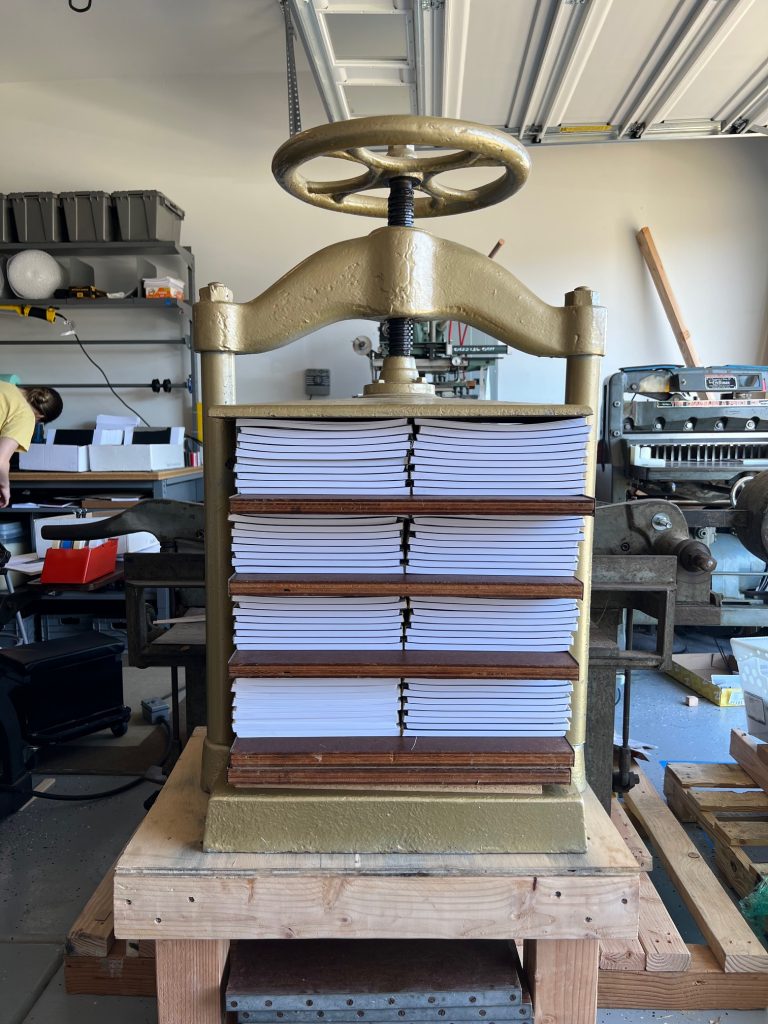
What kicked things off for me is one of the donations that we got. We’re in Corvallis, which is a very small town 50 or 60 miles from the Pacific Ocean on the west coast in rural Oregon. So, a bindery was closing, and I asked them if they would donate some of their stuff to the program here, so that the book students could have a little bit more experience with machines. They said I could come down and look around, and they had exactly the thing that I had been searching for: a signature sewing machine. If you do that by hand, it might take about 25 minutes a copy, which, when you’re dealing with 150 copies, is not an insignificant amount of time. You know, it just takes weeks. This machine that the bindery had was from 1905, they didn’t even know if it worked, but we turned it on and ran it a couple times. But this was April of 2020, right during COVID, and the admin of our university told me to refuse the donation. They said, “Don’t go pick it up.” It was at this point I realized that they just weren’t going to do it.
So, I decided: You know what? I’m just gonna do it myself. I’ll just do it myself.
That was the start of your equipment, but now you’ve got a whole workshop on a shoestring. How did that happen?
Over the next year, I accumulated more equipment from closing binderies for little or no money. You know, some people didn’t even want money for it, they just wanted it out of their space. They were like, “Please just come pick it up.”
There were so many binderies closing?
Yeah, mostly small print shops. I mean, again, COVID. A lot of the stuff was Craigslist finds. For example, my folder was on Craigslist for 700 bucks. My paper cutter, which is this industrial hydraulic paper cutter from 1956 that doesn’t even have an instruction manual, is just a ridiculous piece of equipment that weighs around 2000 pounds. They said, “If you’ll drive to the coast and pick it up, you can have it.” So, it does cost me something to go pick them up.
My goal with the books was to be able to bind them, sew them, fold them, and cut them. That should be the four machines that will get me a book block that’s ready to be put in a case. If I have to case by hand, I have to case by hand, but that’ll take me two weeks—no big deal, compared to the other stuff.
Oh, but the other big thing that made it possible was I convinced the program here to lease a digital press. The idea originally was to use it for the books made by my bookmaking students, because we were printing on inkjet printers, which was both extremely slow (they’d be printing for three hours) and also insanely expensive. Looking back on how much ink we were using, those books probably cost $150 a copy to print, maybe more. It’s just way too much money. The lease for the Xerox press was so cheap by comparison. I thought there was a catch. It’s a different kind of press, but the quality was so good. It’s not exhibition print quality, but definitely good enough—and so fast and so cheap! So, when that happened, I thought, “Okay, well, here we go.”
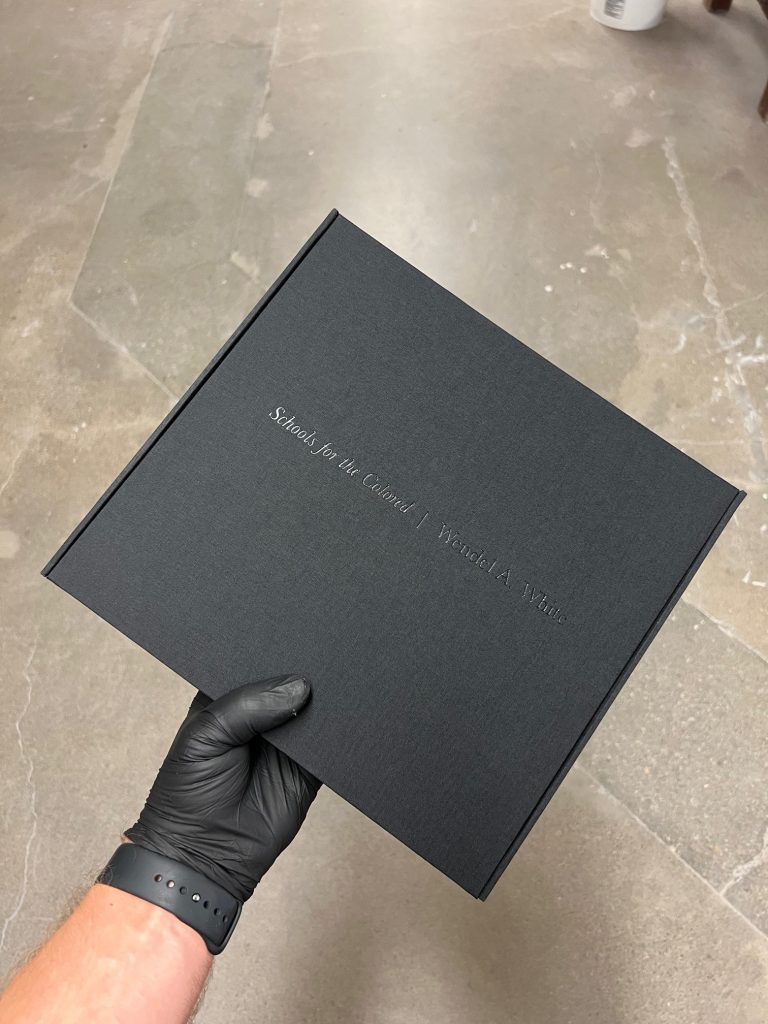
That really changes the equation for producing a photobook.
Definitely, it’s the reason this works for me. The cost of printing, which is the main driver of a book’s cost, is just drastically reduced. I mean, a ridiculously low cost entry. That made it completely feasible. Before that, I was looking at a place to get it printed, and it was something like $25 per copy just for the printing. That could still work, but then I would have to sell out just to break even, basically, and I wouldn’t get paid for my time. With access to a digital press, I’m able to be really comfortable taking on projects that may be more financially risky.
Having all the equipment means there’s nothing that’s farmed out—I do everything. That makes it quite financially feasible. I’m not going to say “cheap,” but certainly financially feasible to the point where I could put out an edition of 150 books for under $2,500, plus my own time.
Candor went out of business during COVID, you know? And now Matt’s on to a new project For the Birds Trapped in Airports; Skylark’s still making it, but I think it’s because they have no physical space. They’re just run out of an office. But, there were a lot of those little presses that just couldn’t make it unless they owned their own equipment.
Plus, I think there’s a real resurgence in people wanting photobooks in small runs of, say, 150 copies. I mean, yes, that’s pretty small… but there aren’t many artists who can sell 2,000 copies of a book. I walk through museum stores and bookstores, and I’ll see copies of books published 10 years ago that are still sitting on the shelves.
What’s your financial relationship with the artists? Are you paying them, are they paying you?
Oh wow, yeah, you know about the upfront costs that photobook companies ask artists to supply? I’ve heard figures everywhere from $25,000-50,000—and to publish your own book?! I said, “Hold on, they approached you? Like, they came to you and said, ‘This would be interesting to publish.’ And you said, ‘Okay,’ and they said, ‘That’ll be $25,000?” I was just shocked. That’s shocking. I just think that model is really exploitative.
One of the artists I’m working with was like, “You know, I just wasn’t willing to mortgage my house to have a photobook.” I’m like, “No kidding.” Some people would rather have a downpayment on a house than, like, a photobook.
So, my deal with artists is like this: I get to pick the artist I want, and I don’t ask for any money. If it doesn’t sell well, I’m still not going to ask you for any money. And I agree to give them x number of books, usually it’s 20% of our initial run. And they can do whatever they want with those copies, whether give them away or sell them to make a little bit of money if they want, but I think most artists want to give those away to people that they know, or to curatorial staff and people in their network. So, it’s a really simple model. There’s not a lot of costs involved, and not a lot of profit involved. But everybody walks away not losing money, which is important.
I can imagine that’s a really attractive option for a lot of artists, so how will you go about choosing future book projects?
Well, where I feel really fortunate is that I teach academically full time, so I don’t have to choose projects based on their profitability. A commercial press—like Mack or Aperture, for example—will need to choose projects that are financially viable. What’s going to sell. But this isn’t what puts food on my table, so I get to just pick the stuff I like. That tends to be color, and photography, and a bit more on the documentary side of things… That being said, a couple of my projects coming up don’t fit that at all, so I also don’t have to adhere to any rules. I just do what I want, which is really liberating.
Also, I don’t want to make outrageously overpriced books either, you know? I don’t want to make books that are $100 a copy. It limits the audience. And I think of my students a lot: What could my students afford?
Why did you choose Wendel’s work for your first book? Did you know him before this?
No, I didn’t know him. I’d seen the work, and I really liked the work. His series, “Schools for the Colored,” explored buildings or places that used to be segregated schools. And I had just listened to a podcast, Malcolm Gladwell’s Revisionist History, that was talking about school segregation. He had done a bunch of episodes on education, which is an interest of mine, and he did an episode on Brown v. Board of Education, which in the US is the big case that overturned Plessy v. Ferguson, which was the case that said you can do segregation as long as everything’s equal. So, as long as a Black school and a white school are equal, then they can be segregated because you’re not disadvantaging anyone—which, of course, was not the case. Schools were not equal. Brown v. Board of Education overturned that rule and ended segregation.
And that sounded like a good thing, but what this podcast got into was the negative fallout. At Black schools, the teachers were also Black. And to those students, they served as a model for a successful, educated, learned person that had power. When the schools were integrated, the white schools did not hire any of the Black teachers, they simply moved the Black students to white schools. For the Black teachers, that was it.
And there were other things that Black teachers would have done for Black students in those schools, like recommending them for scholarship programs, or taking an extra interest in promising students to encourage them. So, maybe those students got better facilities, but how do you expect them to succeed when they both have no role model that looks like them in the classroom, and also, when the teacher, in many cases, didn’t really care about those students’ success, and they’re not going to recommend the Black student over a white student for programs? That really hit me like a ton of bricks. I’d never really thought about that. And Wendel’s work popped back into my mind as I was hearing that.
I thought this would be a good book to start with for a number of reasons: One, he’s a successful artist and a Guggenheim Fellow. Two, the work is strong and there was enough of it. There were 50 images, which is enough to sustain a good publication. And also, I liked the subject matter, and I thought the subject matter was relevant.
You mentioned earlier that you didn’t think your own work could sustain a photobook. How do you think you achieve that?
I’m a big believer in the idea that a book should elevate the work. It shouldn’t just be, “Here’s pictures in a book, look at my pictures.” It should expand upon it in some capacity, and in many cases, that means like incorporating some element that’s not in the exhibiting work, like text or poetry. Having control over the sequence is one thing, but also the materials should reflect the feel of that work.
If I think about my work, “Technically Intimate,” I couldn’t figure out how to make it more than just pictures on a page, which was disappointing because I like that work. I actually think it’s pretty seminal, at least for that time period. It’s the only kind of work that I’ve found that deals with that phenomenon without being terribly exploitative or gratuitously sexual. But I just can’t find a way to put it into publication. It can go into publication with other artists, like in a magazine or a catalog or a book that deals with subject matter, I just don’t think it can sustain itself.
 Considering you also teach bookmaking, what do you see as the difference between the theory and the practice?
Considering you also teach bookmaking, what do you see as the difference between the theory and the practice?
There are very few presses that do everything, right? When it comes to the design aspect, there’s not much difference: You design a book and send it to press and you stay clean while off it goes to someone who knows how to build it. I think the major difference is just how important the level of execution is.
With my students, I tell them: This is a white piece of paper, and you’re responsible now for everything that you do. You’re going to decide what images you’re going to use, and how you’re going to use them, what order you’re going to put them in. And that’s just the where bookmaking starts, because now you’re going to decide the format of the book, the paper size, the paper color, the paper weight. There’s endless choices. Do you want toothy paper? Do you want the smooth paper? Do you want gloss? Do you want matte? Do you want heavy? Do you want light? Are you mixing this stuff?
And they’re already looking at me like they’re a little overwhelmed, and I say: But we’re not even to the outside of the book yet. What are you going to do on the outside to reflect the inside?
There should be a reason for everything that’s done, and it should leave as a complete package. You know, most presses never even see a full-on physical mock-up of the book they’re going to produce. They look at samples of cloth and choose based on that. They choose a foil based on an idea, rather than seeing it in action.
I’m a perfectionist, sometimes to a fault, which is a problem when doing 150 of something. When you’re doing it by hand, not every copy is going to be dead on. So, I think the difference between teaching it and doing it is the level of execution on a repeated basis. I always tell my book students that this isn’t difficult, but it requires repetition and practice. It’s one of those things. It’s not insanely complicated, but it requires that attention to detail, because when you’re doing this kind of stuff you can get bored and stop paying attention.
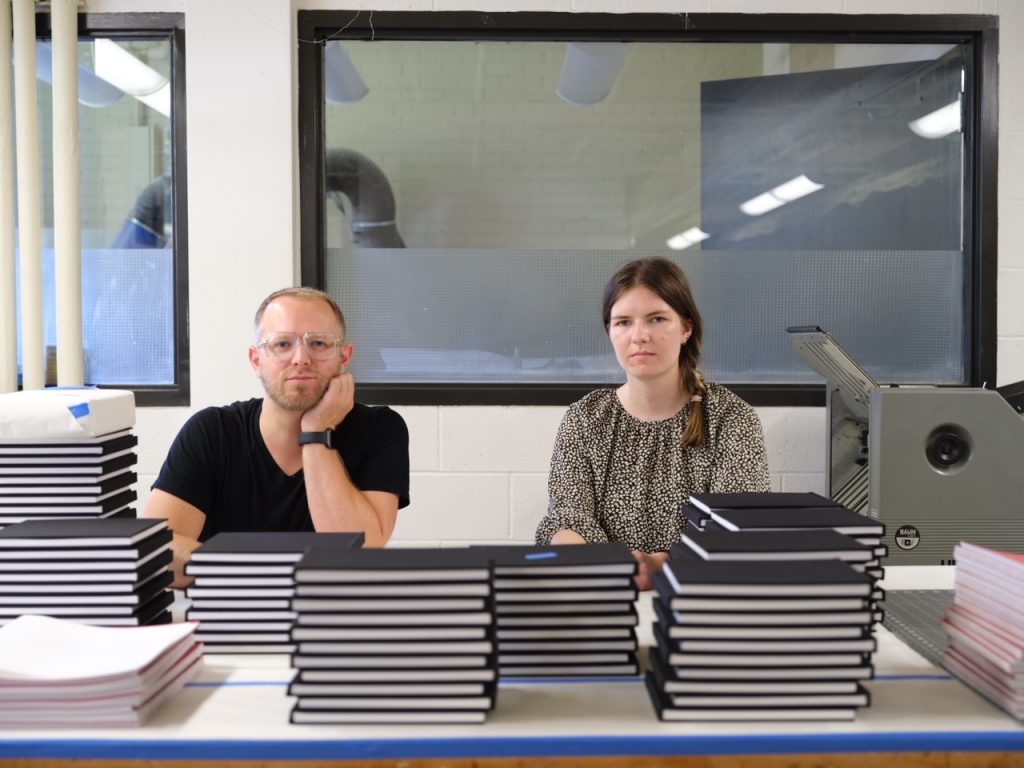
You often talk about how important it is to do things for yourself and to have your own production means. I want to ask you specifically about this, because of course the “means of production” is the classic Marxist separator of classes. What has it meant to you to have the means for your own production?
It’s freedom. I get to do whatever I want at the pace that I want. That’s such a massive advantage in something like this.
It does take a front-end investment, and I understand that’s the scary part. But I think there’s this myth about how expensive things are. I have always been a person who does not like relying on other people to do things for me, and it’s mostly because I’m trying to find a way to not go broke, you know? There are plenty of photographic artists I know who send their work to the framer and pay $2,500 for three pieces, but I can’t spend that money… I just don’t have it. I don’t have it to spend. So, I always look for a way to get something the cheapest way possible. I’ve bought very few things in my life new. The last two cameras that I bought were new, but it’s the first time I’ve ever bought a new camera. I’ve always bought used things, stuff that people don’t want. I mean, my folder is kind of a piece of junk—no commercial enterprise is going to want it—but it still works. Brand new, those are like $20,000, which is insane. I spent in total, on all of my equipment, probably closer to $7,000. That is an upfront investment, but over two years of slowly acquiring things, it hasn’t seemed like much. If you’re willing to wait, you can find the stuff that you need.
You pay those small upfront investments of $1,000 here, $1,000 there, and then you don’t have to pay anyone, for all of eternity, going forward. The sewing machines are a good example. Let’s say you were to find a used one for $5,000. Maybe it costs you a total of $7,000 including transport. That’s quite a bit of money. That’s basically all the revenue from one of the books I produce—all of it. But then you go from sewing a copy by hand in 25 minutes, to sewing it by machine in 30 seconds, and it’s also done tighter and better, and then you also have that machine for every single book thereafter. Wendel’s book took four people an entire week to sew. Whereas, if the machine was up and running then, that would’ve been four hours in my garage by myself.
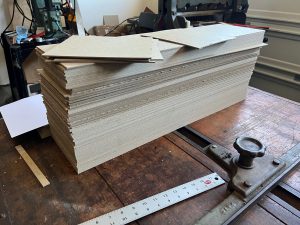 As an example, if I had to do just a single copy of Wendel’s book, a copy takes about 60 seconds to print out. Then, picking that paper up, stacking it and putting it in the folder takes about 30 seconds. Then we have to collate it together so that it’s in the right order. It’s another 30 seconds in the sewing machine, and another 30 seconds to glue it, and you’re talking about a total of around seven minutes a book. When you multiply that by 100 or 200 books, it makes a massive difference.
As an example, if I had to do just a single copy of Wendel’s book, a copy takes about 60 seconds to print out. Then, picking that paper up, stacking it and putting it in the folder takes about 30 seconds. Then we have to collate it together so that it’s in the right order. It’s another 30 seconds in the sewing machine, and another 30 seconds to glue it, and you’re talking about a total of around seven minutes a book. When you multiply that by 100 or 200 books, it makes a massive difference.
You also mentioned before the danger of making mistakes when you’re doing such detailed work on a repetitive basis.
When I have a lot of pressure on, it seems that’s when I execute the best quality. That sounds a little like ego, but it’s really not. I mean it as straightforward. Whenever I give demos to students, they always go wrong. When I’m talking and trying to teach it, and let’s say I’ll be cutting fabric, then I’ll cut the fabric a little too short. Anything that I’ve done as a demo, stuff’s not square. When I make the most mistakes, I find, it’s when I’m not paying attention, or when I’m being too casual about things.
I’m working on the special editions for Wendel’s books now, and it’s been maybe 10 days of this so far. It’s somewhere between five to seven hours per box. So, at this point, a screw-up costs me a day’s worth of work. It’s all high stakes. I’m just kind of surprised that they look so good and so clean. I think one of my better attributes as a person is thinking things through, and I think that’s the thing that saved me to be honest. Because I’ve got a little bit of impostor’s syndrome and I look at them like, who did those books? I’ve been worried for months about doing them, but they look good. I haven’t figured out if it’s because I’m lucky or I’m good.
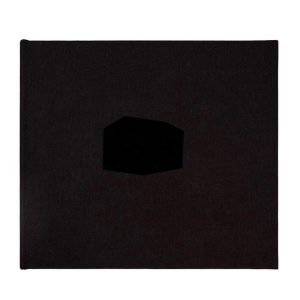
See Wendel A. White’s book, School for the Colored, on the Push Pull Editions website, and see more about Evan Baden’s photographic work on his website.

